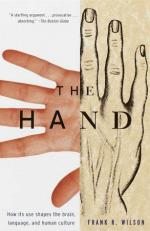
|
| Name: _________________________ | Period: ___________________ |
This test consists of 15 multiple choice questions and 5 short answer questions.
Multiple Choice Questions
1. What is one thing that demonstrates the integration of movement in the shoulder, arm and hand?
(a) The clenching of the fist.
(b) The rotation of the arm.
(c) The rotation of the palm
(d) The unfolding of the fingers.
2. What enables the human to weigh and relate facts to solve problems?
(a) The brain.
(b) The soul.
(c) The hands.
(d) The heart.
3. What does Galvani discover about electrical forces?
(a) They are emitted by a muscle's contractions.
(b) They are charged either negative or positive.
(c) The are initiators of action.
(d) They are shorted out by a muscle's contractions.
4. How many muscles that are attached to the thumb enable it to do its work?
(a) Four.
(b) About six.
(c) Eight or nine.
(d) Twelve or thirteen.
5. From where does Sherrington discover signals originate to cause movement?
(a) The blood.
(b) The brain.
(c) The muscle itself.
(d) The spinal cord.
6. What did hominids require in order to expand their range beyond the jungle?
(a) Opposing thumb.
(b) Agriculture.
(c) Walking upright.
(d) Brain evolution.
7. What is the ability to design and manufacture tools considered by Wilson?
(a) A problem-solving strategy.
(b) The way to take advantage of the hand's capabilities.
(c) The way humans evolve.
(d) The only way the brain can solve mechanical problems.
8. How does the brain teach itself in order to juggle?
(a) By learning how to trigger groups of muscles rather than individual muscles.
(b) By making the brain and hand work together.
(c) By learning how to trigger individual muscles rather than groups of muscles.
(d) By requiring the juggler to repeat a motion over and over.
9. What does the coordination of muscles, tendons, ligaments, and bones do?
(a) It orients the arm and hand to make adjusting and tension-setting movements that keep the body upright.
(b) Creates a system of interrelated functions.
(c) Forms a synergistic system.
(d) Creates tensions to enable movement.
10. According to Wilson, why do children not usually enjoy doing juggling?
(a) They do not have the necessary hand-eye coordination.
(b) They do not the the necessary concentration.
(c) They are too easily bored with trying to learn it.
(d) They do not have the necessary physical stamina.
11. What does Charles Bell say practice enables?
(a) The juggler to talk and juggle at the same time.
(b) The hand and eye to develop as sense organs.
(c) The juggler to juggle and chew gum at the same time.
(d) The juggler to manage a dozen or more objects.
12. Who is Sir Charles Bell?
(a) The only British doctor who performs surgery even after the loss of one hand.
(b) A famous Irish composer.
(c) A Scottish surgeon who is a contemporary of Charles Darwin.
(d) A famous Scottish composer.
13. What does juggling as learned and performed by Percelly provide?
(a) A way to become a professional tennis player.
(b) A way to have fun in becoming a better tennis player.
(c) Good daily exercise.
(d) An entertaining dimension to understanding the mind-body dichotomy.
14. Why is now known to be important that originally was not thought to be so during early studies?
(a) Flexibility.
(b) The thumb.
(c) Strength.
(d) Length of digits.
15. What does Duchenne figure out how to demonstrate?
(a) The way a muscle expands in order to pull.
(b) The way an electrical charge stops movement.
(c) The way a muscle contracts in order to push.
(d) The physiology of movement.
Short Answer Questions
1. Who is David who is mentioned in this chapter?
2. Who is Robin Dunbar?
3. What is the hand's optimal position over the keyboard?
4. What does Frederick Wood Jones note about the hand?
5. How does John Napier identify the terms "power grip" and "precision grip"?
|
This section contains 665 words (approx. 3 pages at 300 words per page) |

|




